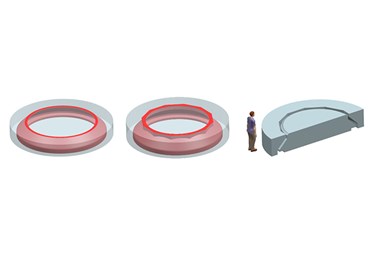Research Partners Building World’s Largest Sand Binder Jetting Printer
3D printing provides flexibility to produce large turbine components near offshore wind projects, lowering transportation costs and offering environmental benefits.

The ACC printer will be designed to print molds for key components of wind turbines, with sizes up 9.5 meters in diameter and 30 to 60 tons in weight. Image: GE Renewable Energy
GE Renewable Energy, Fraunhofer IGCV and voxeljet AG have created a research partnership to develop the world’s largest 3D printer for offshore wind applications in order to streamline the production of key components of GE’s Haliade-X offshore wind turbine. The Advance Casting Cell (ACC) 3D printer under development will benefit from financial support from the German Federal Ministry for Economic Affairs and Energy.
The printer is being designed to be capable of printing molds to cast components for the nacelle of the GE Haliade-X that can each weigh more than 60 metric tons, thereby reducing the time it takes to produce this pattern and mold from 10 weeks or more to just two weeks. In addition, the use of the 3D printer is expected to reduce the product’s carbon footprint by eliminating the need to transport the large parts from a central manufacturing location. The partners expect to launch the project during the end of 2021 with initial printer trials starting during the first quarter of 2022.
The project involves the development of a new, large-format 3D printer capable of producing sand molds for casting the highly complex metal parts of different shapes and sizes that make up an offshore wind turbine nacelle. The modular 3D printing process — which is based on voxeljet’s core binder jetting technology — can be configured to print molds for castings up to 9.5 meters in diameter and 60-plus tons in weight, dimensions.
“The 3D printed molds will bring many benefits, including improved casting quality through improved surface finish, part accuracy and consistency,” says Juan Pablo Cilia, senior additive design engineer at GE Renewable Energy. “Furthermore, sand binder jet molds or additive molds provide cost savings by reducing machining time and other material costs due to optimized design.”
The Fraunhofer Institute for Casting, Composite and Processing Technology IGCV is responsible for casting and materials technology issues as well as digital process monitoring. “We are taking a close look at thermal management during casting, and we will evaluate the ideal proportions of the printing materials,” says Dr. Daniel Günther, head of molding processes and molding materials at Fraunhofer IGCV. “Also, we will develop and test new approaches to process monitoring as part of the project.”
Related Content
-
How Large-Format 3D Printing Supports Micro-Scale Hydropower
There is potential hydroelectric power that has never been unlocked because of the difficulty in capturing it. At Cadens, additive manufacturing is the key to customizing micro-scale water turbine systems to generate electricity from smaller dams and waterways.
-
World’s Largest Metal 3D Printer Seen at Ingersoll Grand Opening Event
Maker of large additive and subtractive machines adds capacity in Rockford, Illinois.
-
“Mantis” AM System for Spacecraft Uses Induction for Deposition
The metal 3D printing system melts wire without lasers. 30-foot-diameter parts are built on a rotary-feed system that eliminates the need for a large machine frame or gantry.














